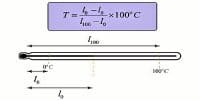As the pressure acts on the surface of contact of the two pieces of ice, the melting point goes down i.e. the melting point becomes less than 0°C. But the temperature of the surface of contact remains at 0°C. So, ice at the surface of contact melts. The required amount of heat needed for melting is collected from the ice. After the removal of pressure the melting point again becomes 0°C. As a result the water obtained from the fusion of ice at the surface of contact again freezes to ice. For this reason if pressure is applied then two pieces of ice unite together to form a single piece.
To melt a solid substance into liquid by applying pressure and again to bring it back to the solid state by reducing the pressure is called regelation.
The melting point of a substance changes due to the variation of pressure on the substance. The changes of melting point may occur in two different ways for pressure.
- The solid substances whose volumes contract on melting, their melting points reduce with the increase of pressure i.e. they melt at a lower temperature.
- The solid substances whose volumes expand on melting, their melting points increase with the increase of pressure i.e. they melt at a higher temperature.













